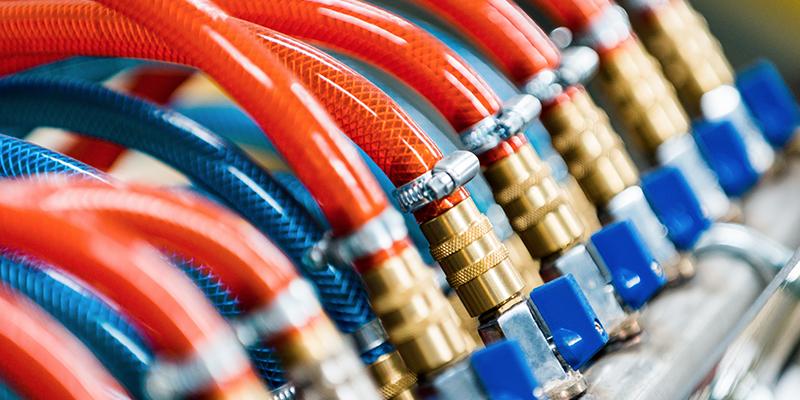The importance of selecting or replacing hydraulic hoses and fittings often gets overlooked until something goes wrong. Engineers must consider several factors before choosing hydraulic hose assemblies, to ensure that these critical parts are correct and fit for purpose. Here, Gates provides some key tips to bear in mind when you’re putting together your hydraulic assembly.
HOSE AND FITTING BASICS Most hoses have three functional layers – the tube, reinforcements, and the cover. Hoses are built and tested according to industry specifications such as SAE and EN and each component is designed to resist the pressures it will encounter, like abrasion, permeation, bending and temperature changes. Engineers should be familiar with specifications related to equipment the hoses they design will go on. They provide guidelines for dimensions, material properties, and minimum performance characteristics for major types of hose and fittings.
Fittings make leak-free connections to the hose (fitting end) and attach the hose to different components in the hydraulic system (termination end). Most fittings have two parts, a stem and ferrule. The stem conveys the fluid, attaches to the hose, and provide a seal between the stem and hose. The ferrule attaches to the reinforcements and serves as a “weather seal” to protect the hose and fitting from the environment. Both are typically made of carbon or stainless steel and are sometimes plated or coated to improve chemical or corrosion resistance.
The termination end forms a leak-free connection between the hose and a port, adapter, or another hose. There are many different types of end connections specified by industry standards (such as SAE J516). Knowing how they fit together is key to selecting the best termination for an application.
DEFINING REQUIREMENTS Size: A hose’s two critical dimensions are inside diameter (ID) and overall length (OAL).
The ID must be sized to keep fluid velocities within recommended ranges. If the ID is too large or too small, it can change fluid flow and hurt machine performance by causing erosion, excessive pressure drop and power loss, too much turbulence (heat generation), pump cavitation, and noise.
The OAL must be sized to provide proper routing. Too short and it puts excessive stress on the hose and fitting and prevents them from bending and stretching due to pressure impulses. If the hoses are too long, they can rub against each other or nearby components, or get caught on something.
When replacing a hose, you can determine the ID by checking the label. If it has been painted over or worn off, do not use the hose OD to identify the hose’s ID. Hose ODs vary according to construction and manufacturer and have no direct correlation to IDs. A better option is to cut the hose and measure the inside diameter. Remember to record the overall length and fitting orientation before cutting the hose.
Temperature: It does not take much extra heat to shorten a hose’s service life. A good rule of thumb says that for every 10°C over a hose’s maximum temperature rating, it shortens the hose’s life by 50 percent.
Be sure to choose hose with an upper limit well above the machine’s operating temperature. Hoses’ temperature ratings, both minimum and maximum, are usually listed in agency specifications, product catalogues, or technical pages. Most ratings are for normal service conditions, but special ratings are sometimes listed for intermittent service. Plastic hose pressure ratings are often reduced by a temperature factor.
Application: Engineers need to document anything special the machine they are designing is expected to do, including safety and environmental risks, and extreme conditions the hose will be expected to handle.
If replacement hoses are being made, ask some questions rather than just duplicating the originals. How did the original hose fail? Does it show signs of cover abrasion or temperature cracks? Does the machine generate pressure surges, or is it more of a static application? Make sure to find a replacement hose that best matches the application requirements, not just the original part.
It’s also a good idea to brush-up on new hose technologies. Over the past several years, some manufacturers have developed hoses and fittings that far exceed the performance and construction capabilities of SAE specifications. Hoses that meet or exceed SAE performance specs but are smaller than standard hose can be good choices.
Material: The most critical hose and fitting material consideration is chemical resistance, so confirm what fluids will run through the hose and what chemicals will touch the fitting bore, ferrule and termination. Always check the fluid’s compatibility not only with the tube, but with the reinforcements, cover, fittings and seals.
Pressure: Working and burst pressures are the two most common pressure ratings for hoses. Working pressure helps select the correct hose based on the hydraulic pressure. System pressures should never exceed a hose’s working pressure. Burst pressure is the maximum pressure a hose can take before catastrophically rupturing. It also provides an estimate of design or safety factor. Burst pressure is usually four times the working pressure for most hoses.
It is critical to know the full range of hydraulic pressures when choosing hose, including pressure spikes.
Hoses‘ working pressures should be greater than or equal to the highest system pressure (including spikes.) Subjecting hose to pressures above its rated working pressure reduces its service life and increases the chances it will fail unexpectedly.
Gates Australia provides a full range of hydraulic hoses and fittings to meet any application.
Click here to view range



